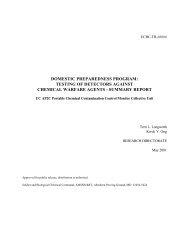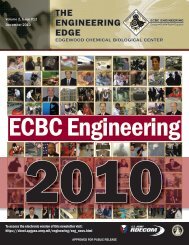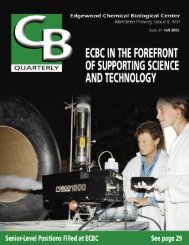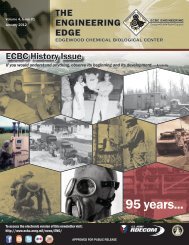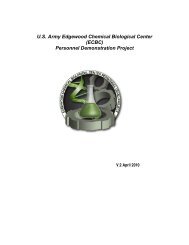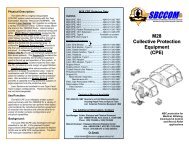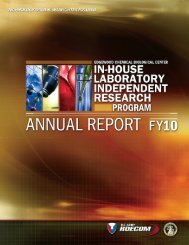(FFPE) with Self-Contained Breathing Apparatus (SCBA) for Rescue
(FFPE) with Self-Contained Breathing Apparatus (SCBA) for Rescue
(FFPE) with Self-Contained Breathing Apparatus (SCBA) for Rescue
Create successful ePaper yourself
Turn your PDF publications into a flip-book with our unique Google optimized e-Paper software.
1-Minute Recon in a HD Environment<br />
1 st Degree Burns<br />
< 4% BSA<br />
25<br />
HD HAZARD LEVEL<br />
2 nd Degree Burns<br />
< 4% BSA<br />
200<br />
0 50 100 150 200<br />
25<br />
50% of firefighters may experience<br />
localized skin reddening, although<br />
level of effect is low and percent body<br />
surface area affected is small.<br />
Percutaneous dosage received by firefighters in turnout<br />
gear and <strong>SCBA</strong> (mg-min/m 3 )<br />
Figure 3. 1-Minute Recon Dosage <strong>for</strong> a HD Environment<br />
Mustard agent acts locally at the site of absorption into the body, there<strong>for</strong>e agent effects<br />
occur at those areas that are more sensitive to the agent or less protected (ears, neck,<br />
armpits and groin). Even though local mustard agent effects can be expected in these<br />
sensitive areas based on short-term exposures, much longer-term exposures are not<br />
expected to result in lethal skin dosages unless firefighters continue to be exposed to<br />
high-vapor concentrations <strong>for</strong> several hours. Thus while local mustard effects may be<br />
produced from exposure during rapid rescue operations, the chance of receiving lethal<br />
dosages remains very small.<br />
5.0 INCIDENT COMMANDER OPERATIONAL CONSIDERATIONS<br />
An incident commander may need to decide the safety and feasibility of firefighters entering a<br />
potentially contaminated room or building to assist <strong>with</strong> rescue and evacuation of known live<br />
victims. The longer victims remain in a chemical agent environment the more susceptible they<br />
are to the effects of the agent. Similarly, the IC may need to decide on risking a reconnaissance<br />
to determine if viable live victims remain.<br />
Based on the in<strong>for</strong>mation provided in this report the following basic operational considerations<br />
can be made:<br />
• The presence of living victims inside the potential hazard area provides the basic indicator<br />
<strong>for</strong> firefighters to assess the level of contamination <strong>for</strong> nerve agents.<br />
• <strong>Rescue</strong> entry occurs after vapor concentration has peaked (assumed approximately ten<br />
minutes after the release of agent).<br />
11



